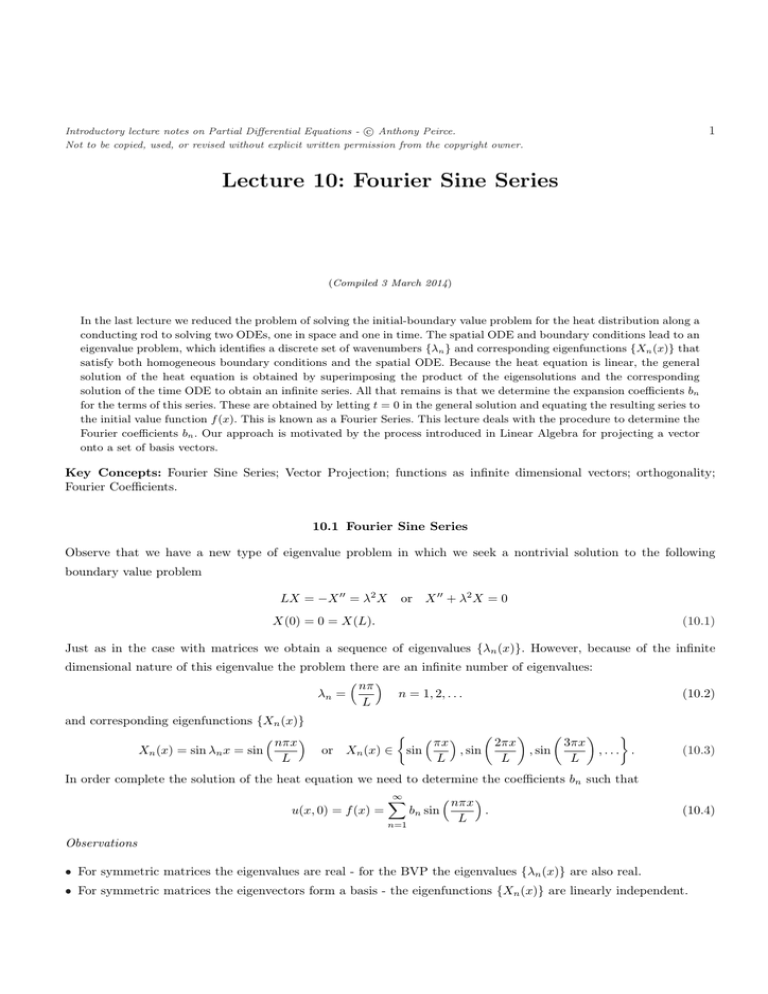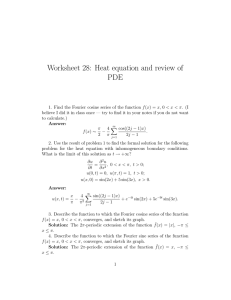1
advertisement

1
c Anthony Peirce.
Introductory lecture notes on Partial Differential Equations - °
Not to be copied, used, or revised without explicit written permission from the copyright owner.
Lecture 10: Fourier Sine Series
(Compiled 3 March 2014)
In the last lecture we reduced the problem of solving the initial-boundary value problem for the heat distribution along a
conducting rod to solving two ODEs, one in space and one in time. The spatial ODE and boundary conditions lead to an
eigenvalue problem, which identifies a discrete set of wavenumbers {λn } and corresponding eigenfunctions {Xn (x)} that
satisfy both homogeneous boundary conditions and the spatial ODE. Because the heat equation is linear, the general
solution of the heat equation is obtained by superimposing the product of the eigensolutions and the corresponding
solution of the time ODE to obtain an infinite series. All that remains is that we determine the expansion coefficients bn
for the terms of this series. These are obtained by letting t = 0 in the general solution and equating the resulting series to
the initial value function f (x). This is known as a Fourier Series. This lecture deals with the procedure to determine the
Fourier coefficients bn . Our approach is motivated by the process introduced in Linear Algebra for projecting a vector
onto a set of basis vectors.
Key Concepts: Fourier Sine Series; Vector Projection; functions as infinite dimensional vectors; orthogonality;
Fourier Coefficients.
10.1 Fourier Sine Series
Observe that we have a new type of eigenvalue problem in which we seek a nontrivial solution to the following
boundary value problem
LX = −X 00 = λ2 X
or X 00 + λ2 X = 0
X(0) = 0 = X(L).
(10.1)
Just as in the case with matrices we obtain a sequence of eigenvalues {λn (x)}. However, because of the infinite
dimensional nature of this eigenvalue the problem there are an infinite number of eigenvalues:
³ nπ ´
n = 1, 2, . . .
λn =
L
and corresponding eigenfunctions {Xn (x)}
³ nπx ´
Xn (x) = sin λn x = sin
L
½
or Xn (x) ∈
sin
³ πx ´
L
µ
, sin
2πx
L
¶
µ
, sin
3πx
L
¶
(10.2)
¾
,... .
(10.3)
In order complete the solution of the heat equation we need to determine the coefficients bn such that
u(x, 0) = f (x) =
∞
X
n=1
bn sin
³ nπx ´
L
.
(10.4)
Observations
• For symmetric matrices the eigenvalues are real - for the BVP the eigenvalues {λn (x)} are also real.
• For symmetric matrices the eigenvectors form a basis - the eigenfunctions {Xn (x)} are linearly independent.
2
10.1.1 Euler’s Column: The Buckling Load for a Beam - perhaps the oldest eigenvalue problem
Eigenvalue problems also arise independently without necessarily coming from a PDE problem. Consider a beam
that is subjected to an axial load P applied to its endpoints. Our experience tells us that as we increase P a critical
load Pc is reached at which the beam starts to buckle.
Figure 1. Buckling of Euler’s column
The Bernoulle-Euler Law: A beam constructed from a material that is known to deform in such a way that the
curvature κ is proportional to the bending moment καM .
In particular,
κ=
y 00 (x)
M
= cM =
[1 + (y 0 )2 ]
EI
where E = Young’s modulus and I = the moment of inertia of the beam. If the deflection of the beam is small
(y 0 )2 << |y 0 | << 1 then we can make the approximation
y 00 =
M
EI
The Bernoulle-Euler Law
When subject to an axial load P as shown in figure 10.1.1, the bending moment on the buckling beam is given by
M (x) = −P y(x)
M
P
y 00 = −
=−
y = −k 2 y
EI
EI
k2 =
P
EI
Thus determining the magnitude of P = EIk 2 for which the beam will first buckle is reduced to solving the following
eigenvalue problem:
y 00 + k 2 y = 0
y(0) = 0 = y(L)
¾
Eigenvalue Problem
y(x) = A cos kx + B sin kx
nπ
y(L) = B sin kL = 0 ⇒ kn =
L
³ nπx ´
nπ
We have eigenvalues kn =
and eigenfunctions yn (x) = sin
. But
L
L
³ nπ ´2
Pn
kn2 =
=
n = 1, 2, . . . .
EI
L
y(0) = A = 0
Therefore the smallest buckling force Pc = P1 =
³ πx ´
Mode is sin
.
L
n = 1, 2, . . . .
EIπ 2
is known as the critical Euler load and the Euler Buckling
L2
Fourier Series
3
10.1.2 Finding the Fourier Coefficients
How do we find the bn in the sine series expansion (10.4) of f (x)?
z
¡
µCC
¡
¡
v2
v3
BM
B
¡
¢̧
¢
B
¢
B
¢
¢
¡
B
..
....
...
...
.
.
..
..
..
...
...
.
.
.
...
...
....
...
........
.............. ....................
CC
...............
...
¡
¡
f (x) ≈ f ....=
(f (x1 ), . . . , f (xN ))
..............
CC
¡
¡
CC
»
»
»
»
:»
»»
¢ ¡
»
B ¢¡»»»»
¢¡»
B»
¡
»
»
...
...
...
....
...
...
...
...
.........
...
............ .................
....
...
.....
...
...... ............
....
.....
........
........
........... ......................
v1
y
¡
x
6
y
f
6
x -
-
L
¡
¡
¡
¡
ª
©
ª
Figure 2. Left side: Expand f in terms of the basis vectors v1 , v2 , v3 ; Right side: Approximation of a function f (x) by a
vector f of sample points with values {f (xk }
Decomposition of vectors into components - projection: How do we expand a vector f in terms of linearly independent
vectors vk ?
Assume f = α1 v1 + α2 v2 + α3 v3
f · vk = α1 v1 · vk + α2 v2 · vk + α3 v3 · vk
v1 · v1 v1 · v2 v1 · v3
α1
v1 · v2 v2 · v2 v2 · v3 α2
v1 · v3
v2 · v3
v3 · v3
α3
=
f · v1
f · v2
f · v3
(10.5)
If vk ⊥ v` , k 6= ` i.e. the vk are orthogonal
αk =
f · vk
vk · vk
(10.6)
Functions as infinite dimensional vectors and projection: But functions are just infinite dimensional vectors:
f ' [f1 , f2 , . . . , fN ]
g ' [g1 , g2 , . . . , gN ]
f · g = f1 g1 + f2 g2 + · · · + fN gN
=
N
X
∆x =
L
N
(10.7)
f (xk )g(xk ).
k=1
The analogue of the dot product for functions is given by the so-called inner product:
ZL
hf, gi :=
f (x)g(x) dx '
0
N
X
k=1
f (xk )g(xk )∆x.
(10.8)
4
Back to finding bn :
f (x) =
∞
X
bn sin
³ nπx ´
µ
hf, sin
(10.9)
L
n=1
¶
µ
¶
µ
¶
ZL
ZL
∞
³ nπx ´
X
kπx
kπx
kπx
i = f (x) sin
dx =
bn sin
sin
dx.
L
L
L
L
n=1
0
0
1
Recall sin(A) sin B = {cos(A − B) − cos(A + B)}. Therefore
2
µ
¶
ZL
³ nπx ´
kπx
Ink = sin
sin
dx
L
L
0
1
=
2
ZL
cos(n − k)
0
πx
πx
− cos(n + k)
dx
L
L
n 6= k
·
¸L
1 sin(n − k)πx/L sin(n + k)πx/L
−
2
(n − k)π/L
(n + k)π/L
0
=0
µ
¶
ZL
ZL
³
´
1
2nπx
2 nπx
= sin
dx =
1 − cos
dx
L
2
L
=
Inn
0
(10.10)
0
= L/2
Therefore the Fourier Coefficients {bn } are given by:
2
bk =
L
µ
ZL
f (x) sin
0
kπx
L
¶
dx.
(10.11)
Example 10.1
½
2x
0 < x < 12
L=1
2(1 − x) 21 < x < 1
1
Z1
Z2
bn = 2
2x sin(nπx) dx + 2(1 − x) sin(nπx) dx
1
f (x) =
0
2
sin(nπ/2)
3 4 5
¡ n¢ = 1 2
=8
sin nπ
1
0
−1
0 1
n2 π 2
2
∞
£
¤
2 2
8 X (−1)k
sin (2k + 1)πx e−(2k+1) π t .
Therefore u(x, t) = 2
2
π
(2k + 1)
k=0
• Observe as t → ∞ u(x, t) → 0 (all the heat leaks out).
∞
£
¤
8 X (−1)k
• u(x, 0) = 2
sin (2k + 1)πx .
π
(2k + 1)2
k=0
∞
X
1
π2
1
•
=
by letting x = ⇒ f (x) = 1.
8
(2k + 1)2
2
k=0
(10.12)
Fourier Series
2 terms of the Fourier Series
1 terms of the Fourier Series
1
0.5
0.5
f(x)
1
f(x)
5
0
−0.5
0
−0.5
−1
−2
−1
0
x
1
−1
−2
2
−1
0
x
1
2
Example 10.2
f (x) = x
0<x<1
L=1
Z1
bn = 2
x sin(nπx) dx = −2
0
cos(nπ)
(−1)n+1
=2
nπ
nπ
∞
2
2 X (−1)n+1
Therefore u(x, t) =
sin(nπx)e−(nπ) t .
π n=1
n
(10.13)
• As t → ∞ u(x, t) → 0.
∞
2 X (−1)n+1
• u(x, 0) =
sin(nπx).
π n=1
n
µ
¶
1
1
u
,0
=
=
2
2
•
2
π
=
1−
1 1
+ − ....
3 5
∞
P
n=1
∞
X
k=0
(−1)n+1
n
sin(nπ/2)
(−1)k
(2k + 1)
k
0
1
2
n
1
2
3
4
5
sin
¡ nπ ¢
2
1
0
−1
0
1
(10.14)
2 terms of the Fourier Series
1 terms of the Fourier Series
1
1
0.5
0.5
f(x)
=
f(x)
π
4
2
π
0
−0.5
−0.5
−1
−2
0
−1
0
x
1
2
−1
−2
−1
0
x
1
2
6
MATLAB Code:
%fourier sine example
clear;clf;dx=0.001;dt=0.001;
x=-2:dx:2;xr=0:dx:1;nterms=10;ntime=100;
for nt=1:ntime
t = (nt-1)*dt;
for n=1:nterms
K=1:1:n;
u(:,n+1)=2*(sin(pi*K'*x)'*((-1).^(K+1).*exp(-pi^2*K.^2*t)./K)')/pi;
plot(x',u(:,n+1),'r-',xr',xr','k-','linewidth',2);ax=axis;ax=[0 1 0 1.2];axis(ax);
tit=[num2str(n+1),' terms of the Fourier Series '];title(tit);xlabel('x');ylabel('u(x,t), f(x)=x');pause(.01)
end
if mod(nt,5)==0,pause(.02);end
end






